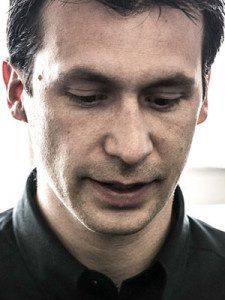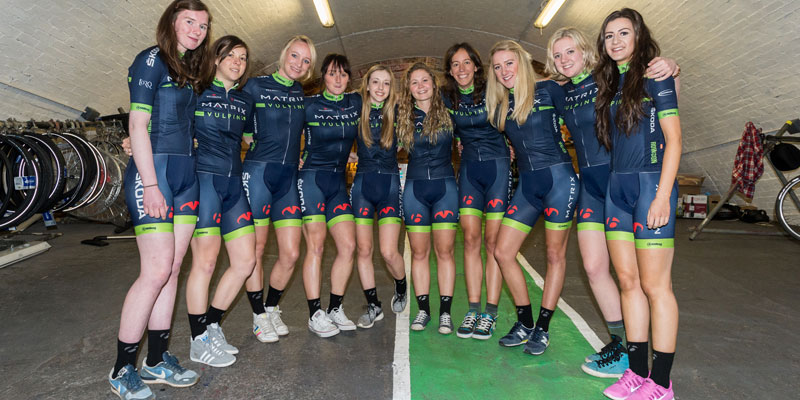Stefan Wyman is Sports Director and Manager for the Matrix Fitness – Vulpine Women’s Cycling Team. Previously a rider himself, Stefan entered the world of team management in 2004 joining Team FBUK to support his wife, an aspiring professional cyclist, after her early career was let down by a lack of structure and opportunity in the sport. The team Matrix Fitness – Vulpine team recently took part in the Matrix Fitness Grand Prix Series, which was televised on ITV4 and finished in Woking after five rounds held around the UK.

“…I’m now working very hard to secure the services of a female team manager for 2015. This is the next area of advance for the sport; retaining women riders to lead the sport…”
Please can you tell us about your cycling career to date?
I’m now in my tenth year managing women’s teams from the UK. I came into the sport to try to support my wife who was an aspiring professional cyclist.
Her early career was going from let down to let down with disorganised teams and a lack of structure and opportunity. I intended to do what little I could to give her a stable environment to realise her potential.
Although I’m not doing this for my wife now, the goal is still the same. Create a stable environment for riders in which they can best progress and achieve in the sport.
When did your passion begin?
I’ve been involved in cycling all my life. My father was a racing cyclist, and I did my first race at the age of five. I loved racing, but I couldn’t pedal fast enough to win major races myself so it was always more of a hobby.
Once I was involved in the team management side of the sport I really got more interested and wanted to see what I could achieve. Within three years I had registered the UK’s first ever professional team with the UCI and that’s exactly where we want to be in 2015 with the Matrix Fitness Vulpine project.
How was the Matrix Fitness – Vulpine team formed?
Jon Johnson from Matrix Fitness approached me at the end of 2009. He had entered cycling sponsorship that year and wanted to progress things. Initially I turned down the opportunity, in fact, I turned him down a few times. But in the end I think our joint passion for progressing the sport was key to me deciding to stay involved.
The key thing was we shared a vision to get women’s cycling on TV. We wanted this to happen as quickly as possible and we approached the SweetSpot organisation to see if we could get a women’s event as part of the popular Tour Series races.
They welcomed the idea and now we have five races each year that are stand out events on the UK calendar. SweetSport have gone on to organise the Women’s Tour, and I’d like to think our introduction to women’s racing for them has something to do with their interest in trying to run the world’s best stage race.
How do you get the right mix of members with complementary skills?
Getting the mix of riders right is very important, off the bike as much as on it. Our riders rely on each other to get results. They have to have total faith they will get the support when they require it. One person off plan leads to us under performing. It’s an ongoing thing and takes careful management from riders and staff, but it’s as essential as training to be honest.
How did you develop the team relationship with your sponsors?
I worked in business before running teams. I understand profit and loss. I understand the board room. I understand points of return.
So for me not just being a bike rider in the past really helps. I like to think I can understand the unique needs of a business and identify the ways in which we develop their business alongside a successful women’s cycling team. It’s worked until now, so something is going well.
What sort of a difference have these resources made to your ability to compete?
One of the biggest areas is putting the right people around the team. We have excellent advice and input from media experts for example. I have a former National team manager regally with the team as a mechanic now. His input and experience is very valuable as we have more eyes on each situation.
I’m now working very hard to secure the services of a female team manager for 2015. This is the next area of advance for the sport; retaining women riders to lead the sport.
Please can you tell us about the Matrix Fitness Tour Series and how the team based racing works?
The Matrix Fitness GP is a unique set of race. There are five races with an individual winner at each race. But the top riders on the night win points to count towards team and individual rankings. There is also a sprint competition. So there is lots to play for team.
These races are in town centres with TV coverage and excellent crowds. They are very well organised and exciting for the riders.
The tour has managed to secure coverage on terrestrial television in the UK (on ITV4). This is quite a feat.
Why do you think that broadcasters still show so little women’s sport?
I think historically it just wasn’t done and there is still a legacy of lingering over the sport (And other women’s sports). It’s a shame as I think in recent years, major events like the women’s road race at the Olympics show us that women’s racing can be as, or more, exciting that men’s racing.
How can we change this?
I think the solution is to run women’s events on their own. There has always been a call for major men’s races to have a women’s race. As well as that there is a call for all men’s teams to be forced to have a women’s team. I’m not necessarily brought into that philosophy.
There is a place for it, but as with the Women’s Tour, we have seen that women’s sporting events can stand alone. They can be fast, exciting and full of passion. There wasn’t another event to share the limelight and the TV coverage was very good indeed.
How does this tour sit alongside other women’s events?
The Women’s Tour was the best organised stage race I’ve ever been to. The organiser, SweetSpot, came to the table with no preconceptions about what standards women’s races should be run at: specifically, what low standards are seen as acceptable.
From media and communication to accommodation and facilities, this race set a new standard. It could well be the start of revolution in the sport and hopefully it has opened the door to other commercial organisations getting involved.
There is a women’s Tour de France being held this year for the first time since 1989. Why the long wait?
When the TdF finished for women it was replaced with a standalone women’s event, La Grand Boucle the next year. That ran up to 2009 when it ended. The new event is a symbolic thing; it’s a one day event, so not really a Tour, but it will certainly be the best showcase in the world for women’s cycling with its live coverage being beamed around the world.
I hope the new event shows a few things. Firstly, that organisers and sponsors are realising women’s racing can bring commercial returns. Secondly and most importantly, it shows that female advocacy of women’s sport works.
Women’s cycling is still dominated by men and to me that’s a very odd thing. We need the leading riders like Vos, Pooley and Armitstead to keep up this level of advocacy; it’s having a real effect.
How can we eliminate the disparity between the salaries of female and male athletes?
Regulation. It’s simple. Someone at the UCI (Union Cycliste Internationale) needs to have to strength to introduce a minimum salary for women, as the men have. They need to overhaul the regulations to have a two tiered system of registration and be brave in their plans for the progression of the sport.
Women’s cycling is advancing through evolution, not revolution. But swift and concise changes to the regulations governing the sport can ensure that evolution is keeps its fast momentum going.
How do women’s and men’s racing techniques differ?
There are some changes, like the number of riders in a team on race day, the length of the race and often the terrain that all play a part. But ultimately racing is about being over the finish line first.
As the races develop, and as team employ better coaching and riders have more opportunities like salaries, then the techniques and differences will lessen.
What is next for the team?
I’m focused on professional registration for 2015. That’s the goal. I need to put the right riders together and secure the right race program. We have the financial backing in place, so now it’s the details that will determine how successful we can be in the coming two to three years.
On The Drops – Season Update http://www.onthedrops.cc/
https://twitter.com/onthedrops
https://www.facebook.com/womenscycling





